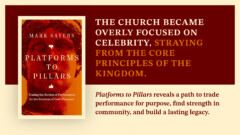Every person knows the difference between pure light and pure darkness. But what is harder to discern is where the light ends and the darkness begins. Where is the point where the light has ended and dark has overtaken? To take this question to a spiritual realm, when has a Christian left the edge of the light of truth and entered the darkness of error? It is this daunting question that Ed Stetzer and Elmer Towns seek to explore in Perimeters of Light: Biblical Boundaries for the Emerging Church.
Before I proceed I would like to point out that throughout this book, “emerging church” is not capitalized. Hence the authors are referring to the evangelical church as it struggles to find its identity in our newly postmodern society (as it emerges from modernism into postmodernism), and are not referring to the subset of this, popularly known as the Emerging (or Emergent) Church. This book contains no references to Brian McLaren, Dan Kimball, Leonard Sweet, or any of the other leaders of the Emergent conversation. Having said all of that, this book is still relevant to that discussion, as the authors seek to define biblical boundaries for what is and what is not Christian. They try to define just how much the church can change and adapt before it is no longer the church.
Woven throughout the text is a parable of two missionaries, which describes two men who are trying to reach an isolated tribe in Papua New Guinea. Their trek through the jungle emphasizes the importance of keeping a light flickering in the darkness, and their struggles in presenting the gospel to the tribesmen describes many of the issues we face in presenting the gospel to our postmodern family, friends and neighbors. The authors correctly believe that in a post-Christian culture like our own, the difficulties we face are much the same as those faced by missionaries taking the good news to cultures that have never known God. There are surprising similarities between a post-Christian culture and a non-Christian culture.
Among the difficult issues the authors wrestle with are: what makes something Christian? (when has a Christian left the light and entered darkness?); the difference between meanings and forms (how and why are decisions in Christian ministry often based on preference and culture instead of the truth of Scripture?); and boundaries in practice (where is the perimeter between true evangelism and unbiblical evangelism?). Following discussion of each of these areas, they seek to apply them to five spheres: church, worship, music, preaching and evangelism.
In discussing the church, Towns and Stetzer define the church and describe the elements that identify a body we can legitimately refer to as a church. They also try to help the reader understand when a church is no longer a church according to biblical standards.
The chapter on worship avoids becoming bogged down in discussions about the “worship wars” which plagued the church until recently (and in many places continue to do so). They talk about the dangers of consumer worship, wherein people attend church in order to have their needs met, rather than to engage in genuine worship of God. They include a helpful section where they try to answer the question of “what makes worship Christian?.”
The discussion then turns to music where the authors again refuse to participate in the worship wars. They teach that God has no stylistic musical preference. They then propose an eight-part test through which we can discern if our music brings glory to God: The message test, the purpose test, the association test, the memories test, the proper association test, the understanding test and the music test.
The following chapter deals with preaching and the authors stress the importance of biblical preaching which is expositional, without committing to traditional expository preaching. They show how in many cases, pastors who seek to be relevant by illustrating their sermons with movies, in reality use the Bible to illustrate their sermons on movies, rather than using movies to illustrate their sermons on the Bible. The balance of the chapter is spent describing different ways of formatting an expositional sermon and ensuring that the listeners will hear and remember it.
Finally the authors turn to evangelism, presenting several of the traditional charts and diagrams used to show the process of evangelism and the way different people respond to the gospel. They propose a new model that takes into account the importance postmoderns place on narrative.
“Christianity in a Postmodern world” seeks to define postmodernism and describe the emphases that are important to people in this society. They show the following shifts: relationship over task; journey over destination; authenticity over excellence; experience over proposition; mystery over solution; diversity over uniformity. The church can react to postmodernism in one of four ways: ignore or dismiss it, attack it, adopt it, or present the truth church. The authors feel that if we can only present the church as God intends it, we have nothing to fear and everything to gain.
The book closes with a chapter discussing the perimeter of truth, suggesting that there are five perimeters to Christianity that cannot be crossed nor tampered with: Jesus, the gospel, biblical doctrine, Christian experience and God’s blessing. They conclude with the well-known creed adopted by many churches: “In essentials, unity. In nonessentials, tolerance. In all things, love.”
Through the book I found that the authors did a better job at asking the questions and providing food-for-thought than in actually answering the questions. But I do not consider this a weakness. They answer the questions that must be answered – the questions of nonnegotiable truth. But they do the best they can to avoid making judgments based on their culturally-conditioned understanding of church or worship.
In the foreword to Perimeters of Light, Paige Patterson writes, “My guess is that few readers will find themselves in agreement with all of the observations of the authors. Not only did I find myself disagreeing, but I also found myself frequently coming to conclusions quite different from those of the authors (page 8).” His predominant concern seems to be an overemphasis on creativity. My experience was much the same. The overemphasis on creativity, especially in worship, leaves unanswered the discussion of the pattern of worship we know as the regulative principle. Are we to worship only in the ways God has commanded or are we free to adapt as we see fit? The authors do not interact with a principle that many believers hold near and dear.
Patterson goes on to say why he felt he could still endorse this book. “[F]irst, there is much with which I do agree and which needs to be said. Second, and more important, the book is one of the few efforts I have seen actually to think through philosophically, exegetically, theologically, and even missiologically an approach to vigorous and successful activity in the church today” (ibid). And he is exactly right. Towns and Stetzer place great emphasis on the unchanging nature of truth and the importance of propositional truth in the areas where the Bible provides no other option. They affirm the predominance of Scripture in all activities of the church. Because of their honesty, sincerity and godly desire to present the truth, I enjoyed this book and am happy to recommend it to others.
| Rating | Evaluation |
|---|---|
| ★★ | Theology/Accuracy A few weaknesses, but generally the theology is Bible-based. |
| ★★ | Readability Quite easy to read and understand. |
| ★★ | Uniqueness Many books address postmodernism, though few as thoroughly or as well as this one. |
| ★★ | Importance An important book that deals with an important topic. |
| Overall I recommend this to anyone concerned about being a biblical church for the 21st century, but with the caveats expressed in the review. |










